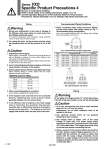
7-p0101-0151-newvxd_en 53 / 55
10秒後にBOOKのページに移動します
Series VXD Specific Product Precautions 4 Be sure to read before handling. Refer to front matter 41 for Safety Instructions, pages 17 to 19 and the Operation Manual for 2 Port Solenoid Valves for Fluid Control Precautions. Please download it via our website, http://www.smcworld.com Recommended Unacceptable Fig. 2 Binding tubes with bands Fig. 1 Recommended piping configuration Straight portion Mounting pitch A Recommended Piping Conditions 1. When connecting tubes using One-touch fittings, provide some spare tube length shown in Fig. 1, recommended piping configuration. Also, do not apply external force to the fittings when binding tubes with bands etc. (see Fig. 2.) 4. When connecting piping to a product Avoid mistakes regarding the supply port etc. 5. If the regulator and solenoid valve are connected directly, chattering may occur as both of them generate vibration. Do not connect them. 6. If the effective area of piping on the fluid supply side is restricted, the operation may become unstable due to differential pressure fluctuation during valve operation. The piping on the fluid supply side should match the port size of the valve. Tightening Torque for Piping Connection thread Rc1/8 Rc1/4 Rc3/8 Rc1/2 Rc3/4 Rc1 7 to 9 12 to 14 22 to 24 28 to 30 36 to 38 Proper tightening torque (N・m) Tube size Mounting pitch A Unit: mm Nylon tube Soft nylon tube Polyurethane tube 44 or more 84 or more 89 or more 112 or more 140 or more 168 or more 35 or more 66 or more 70 or more 88 or more 110 or more 132 or more 25 or more 39 or more 57 or more 52 or more 69 or more 88 or more Straight portion length o1/8" o6 o1/4" o8 o10 o12 16 or more 30 or more 32 or more 40 or more 50 or more 60 or more Wiring Warning Do not apply AC voltage to Class “H” coil AC type unless it is built in full-wave rectifier, or the coil will be damaged. Caution 1. As a rule, use electrical wire with a cross sectional area of 0.5 to 1.25 mm2 for wiring. Furthermore, do not allow excessive force to be applied to the lines. 2. Use electrical circuits which do not generate chattering in their contacts. 3. Use voltage which is within ±10% of the rated voltage. In cases with a DC power supply where importance is placed on responsiveness, stay within ±5% of the rated value. The voltage drop is the value in the lead wire section connecting the coil. 4. When a surge from the solenoid affects the electrical circuitry, install a surge voltage suppressor, etc., in parallel with the solenoid. Or, adopt an option that comes with the surge voltage protection circuit. (However, a surge voltage occurs even if the surge voltage protection circuit is used. For details, please consult with SMC.) Piping Warning Caution 1. During use, deterioration of the tube or damage to the fittings could cause tubes to come loose from their fittings and thrash about. To prevent uncontrolled tube movement, install protective covers or fasten tubes securely in place. 2. For piping the tube, fix the product securely using the mounting holes so that the product is not in the air. 1. Preparation before piping Before piping is connected, it should be thoroughly blown out with air (flushing) or washed to remove chips, cutting oil and other debris from inside the pipe. Install piping so that it does not apply pulling, pressing, bending or other forces on the valve body. 2. Avoid connecting ground lines to piping, as this may cause electric corrosion of the system. 3. Always tighten threads with the proper tightening torque. When attaching fittings to valves, tighten with the proper tightening torque shown below. A 150